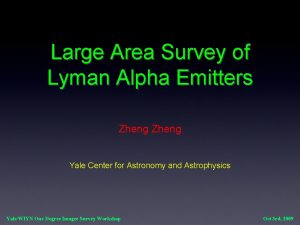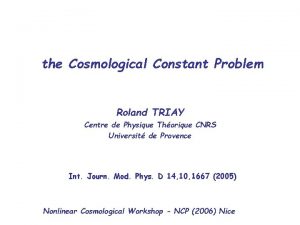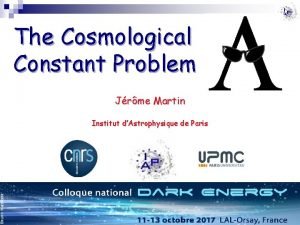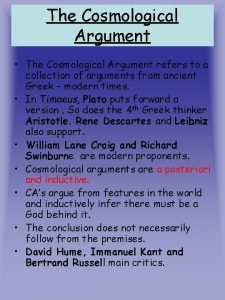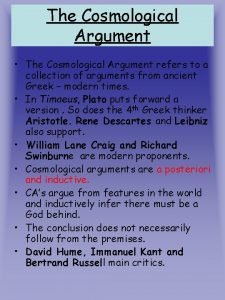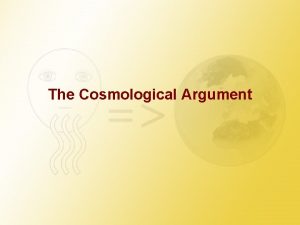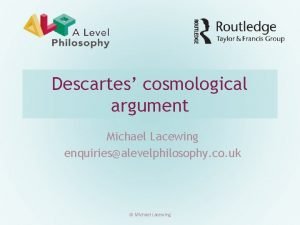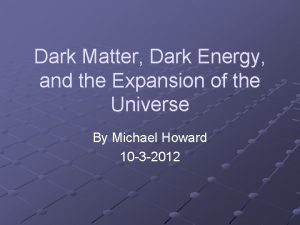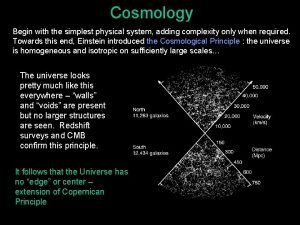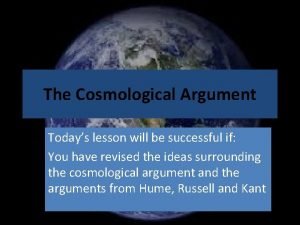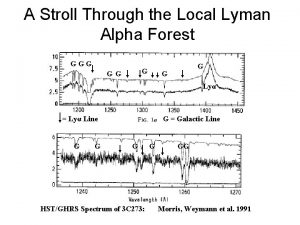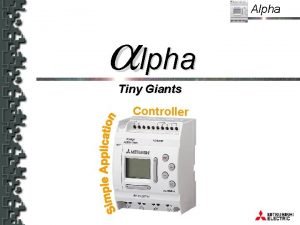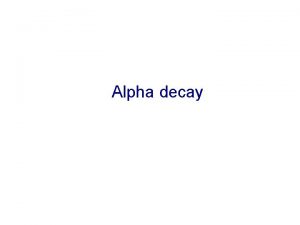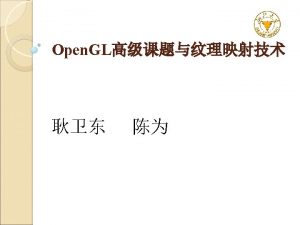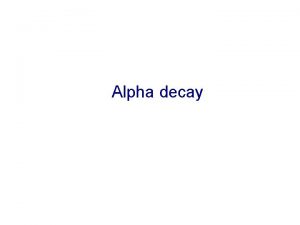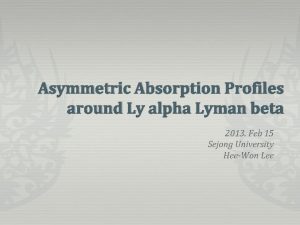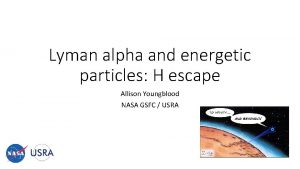Cosmological Structure with the Lyman Alpha Forest Jordi
















- Slides: 16

Cosmological Structure with the Lyman Alpha Forest. Jordi Miralda Escudé ICREA, Institut de Ciències del Cosmos University of Barcelona, Catalonia Edinburgh, June 26 2013

Lyα absorption spectra are a fluctuating Gunn-Peterson optical depth mapping large-scale structure of the universe Without thermal broadening: the Lyα optical depth depends on the overdensity δ and peculiar velocity gradient η

BOSS: galaxy and quasar spectroscopy • Mc. Donald & Eisenstein (2007) proposed to add z>2 quasar spectroscopy in BOSS with the promise to measure large-scale structure and Baryon Acoustic Oscillations using the Lyα forest. • Over 100, 000 quasar spectra at z>2 now offer a huge opportunity for doing large-scale structure studies with absorption systems.

What we measure: Lyα correlation function • • In every quasar spectrum pixel: • The small-scale variations in δF are large. Large-scale power is measured once the small-scale variance is averaged out with many lines of sight. Linear galaxy density fluctuation in redshift space: • Same for Lyα forest:

What we expect: linear theory • For a single Fourier mode, peculiar velocity gradient: • Galaxies: • • Lyα forest: Power spectrum in redshift space: • In one dimension: Kaiser 1987; Hamilton 1992; Croft et al. 1998, 1999, Mc. Donald et al. 2000; Mc. Donald 2003

First year results: redshift distortions (Slosar et al. 2011) • • The anisotropy is clearly detected in the correlation function, consistently with Kaiser’s linear formula. Fitting model:

Galaxy correlation function in redshift space Reid et al. 2012, BOSS DR 9 galaxies

Results: multipoles

Results: best fit model • • • β = bη /bδ f(Ω) = 0. 87± 0. 13 (subject to uncertainties from broadband systematic errors and effects of DLAs and Lyman limit systems). Most accurately measured: bδ (1+β)= - 0. 34± 0. 01 More “usual” bias definition: The shape is consistent with P(k) from CDM. This is the first measurement of redshift distortions at z > 2 with any tracer and technique. The Lyα forest is a new method for studying the large-scale structure of the universe.

Cross-correlations in BOSS • In addition to the Lyα forest transmission auto-correlation, we can measure cross-correlation with several other things: - Damped Lyα absorption systems (Font-Ribera et al. ) - The quasars themselves (Font-Ribera et al, O’Connell et al. ), where the BAO can also be measured! - Metal lines (Pieri et al. ) - Lyα-Lyβ (Irsic et al. ) • Each one of these cross-correlations can yield a bias measurement of a new population, which is related to host halo masses. Cross-correlation power spectrum: •

The small-scale power spectrum: predictions from hydrodynamic simulations (Andreu Ariño, Matteo Viel) Varying power spectrum amplitude Varying gas temperature

A physically based, 7 -parameter formula for fitting the non-linear Lyα power spectrum • This improves over the previous formula used by Mc. Donald (2003) that had 3 more parameters and did not have a correct large-scale limit.

Measurements of the 1 -dimensional power spectrum (Palanque-Delabrouille et al. ) • For the future: measure the small-scale 3 D power spectrum, and fit both P 3 D and P 1 D to non-linear models obtained from simulations.

The radiation intensity also fluctuates: effects on the Lyα power spectrum (with Satya Gontcho, Nicolás Busca) • • The observed Lyα power spectrum does not just depend on the density and peculiar velocity gradient fields, but also on fluctuations of the hydrogen photoionizing background, and on large-scale temperature variations induced by He. II reionization. An approximate large-scale treatment of these fluctuations can be done analytically, assuming source have fluctuations δs that follow density fluctuations with bias factor bs and the mean opacity κ 0 also fluctuates with bias factor ba

Effects of clustering of the ionizing sources and absorbers on the power spectrum • • Broadband effects are introduced in the large-scale power spectrum. The He. II reionization effects should be similar, but affecting smaller scales because of the smaller He. II-ionizing radiation mean free path.

Conclusions • • • The Lyman Alpha Forest is a new tracer of large-scale structure in the universe. It has various advantages over galaxy surveys: each spectrum gives a map over a whole line of sight instead of a single redshift, and the bias factors and non-linear power may be more easily understood from the physics of hydrodynamic simulations than in the case of galaxies. There are, however, extra complications in the Lyman Alpha forest owing to radiation fluctuations and He. II reionization, but we can search for these effects and hopefully understand them and relate them to the population of HI and He. II-ionizing sources. A multitude of cross-correlations will give crucial information on the relation of galaxies, IGM, quasars, and metals.
 Lyman alpha blobs
Lyman alpha blobs Cosmological constant
Cosmological constant Cosmological constant
Cosmological constant St thomas aquinas cosmological argument
St thomas aquinas cosmological argument St thomas aquinas cosmological argument
St thomas aquinas cosmological argument St thomas aquinas cosmological argument
St thomas aquinas cosmological argument Descartes cosmological argument
Descartes cosmological argument Einstein cosmological constant
Einstein cosmological constant The universe expanding than
The universe expanding than Ontological cosmological teleological
Ontological cosmological teleological Kant's criticism of cosmological argument
Kant's criticism of cosmological argument Cosmological argument poster
Cosmological argument poster Kalam cosmological argument
Kalam cosmological argument Phi beta sigma logo
Phi beta sigma logo Npte pharmacology
Npte pharmacology Alpha kappa alpha membership intake process manual
Alpha kappa alpha membership intake process manual 1906 black fraternity
1906 black fraternity
